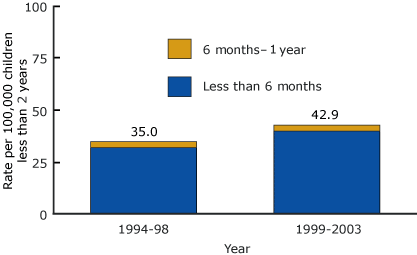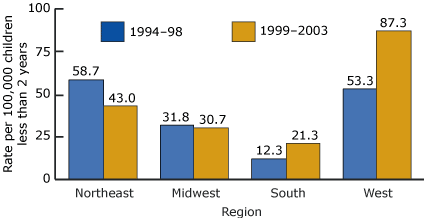NCHS Data on Pertussis Hospitalizations in Young Children
On this Page
by Leah Sirkus, M.P.H.; Susan Lukacs, D.O., M.S.P.H.; and Amy Branum, M.S.P.H.
Pertussis
Pertussis, or whooping cough, is an infectious disease of the upper respiratory tract characterized by coughing spasms (or paroxysms) often followed by an inspiratory whoop or vomiting (1). Symptoms can last for several weeks. Adolescents and adults with pertussis generally have mild symptoms not requiring hospitalization but are an important route of transmission of pertussis to infants. Infants with pertussis, especially younger than 6 months, often require hospitalization for supportive care for coughing spasms and feeding difficulties (3). Complications can include pneumonia, encephalopathy, seizures, and death (3).
Pertussis Vaccine
A vaccine to prevent pertussis in young children has been widely used since the 1940s. Currently, it is recommended that children receive a primary 3-dose series at 2, 4, and 6 months of age and two booster immunizations at 15-18 months and 4-6 years of age. Despite high vaccination coverage rates (over 80% of children 19-35 months of age have received four doses), the incidence rate of pertussis has gradually increased since the 1980s. Surveillance indicates that the greatest increase in rates of pertussis have occurred for adolescents and adults, possibly due to waning vaccine immunity or a change in the reporting of the disease (1,2).
Findings
Trends
There were about 17,000 pertussis hospitalizations in children under 2 years of age during the 5-year period 1999-2003, compared with about 13,800 hospitalizations in 1994-98. The hospitalization rate increased by 23% from 1994-98 to 1999-2003.
Figure 1. Pertussis Hospitalization Rate Among Children Under age 2 Years: United States, 1994-98 and 1999-2003

Among all pertussis hospitalizations during 1994-2003 in children under age 2 years, 92% occurred in infants under 6 months of age. This suggests that children too young to receive immunization or to have developed adequate protection from immunization are most likely to be hospitalized for pertussis.
Regional Differences
Pertussis hospitalization rates also varied by geographic region. Rates were higher in the Northeast and the West compared with the other regions. Between 1994-98 and 1999-2003 rates increased nearly twofold in the West, and also increased in the South, but did not change significantly in the Midwest.
Figure 2. Pertussis Hospitalization Rate Among Children Under age 2 Years, by Region: United States, 1994-98 and 1999-2003

The variation in hospitalizations may be associated with differences in vaccination exemption policies and rates of exemption by geographic region. Areas with high exemption rates have been shown to create pockets of susceptible populations, which subsequently lead to outbreaks of disease (4,5). All States grant exemptions for medical reasons, however, only some offer religious and philosophical exemptions. The West has the highest proportion of States that offer all three types of exemptions, and data from the National Immunization Survey suggest that States that allow philosophical exemptions have significantly higher rates of unvaccinated children (6). It has been suggested that in some western States, it may be easier to claim an exemption than to acquire all vaccinations required for school entry (7).
Expected Source of Payment
The proportion of pertussis hospitalizations among children under age 2 years that were expected to be paid for by Medicaid or other government funding increased by 58% between 1994-98 and 1999-2003. In 1999-2003 Medicaid or other government funding was the expected source of payment for the majority of pertussis hospitalizations among young children.

This shift in the source of payment could be partially explained by a series of Medicaid expansions that raised eligibility thresholds to cover more children. Additionally, rising premiums and cost-sharing involved with private insurance may have influenced lower-income families to switch to Medicaid or public insurance (8).
Conclusions
In 1999-2003, pertussis hospitalization rates were highest for children under 6 months of age and children living in western States. Medicaid was the source of payment for the majority of pertussis hospitalizations.
Children under 6 months of age are too young to receive adequate protection from immunization. A booster vaccine was recently licensed in 2005 for adolescents and adults, and recommended for adolescents by the Advisory Committee on Immunization Practices (ACIP) of CDC (9). Increased vaccination coverage in adolescents and adults may lead to fewer infants contracting pertussis, which may result in decreased morbidity and fewer hospitalizations in young infants.
About the Data
Rates of hospitalizations due to pertussis, were estimated using the National Hospital Discharge Survey (NHDS), which is a representative survey of the Nation’s non-Federal, short stay hospitals (10). Hospitalization rates of children under 2 years of age with a whooping cough diagnosis (ICD-9 codes: 0330, 0331, 0338, and 0339) were analyzed from 1994-2003. It is important to note that the NHDS captures discharges rather than patients. Thus, these data may include some re-hospitalizations due to relapses among infants in addition to initial hospital stays for pertussis, although there is no evidence to suggest that the frequency of re-hospitalizations has changed over time. For more information, see the NHDS.
References
- Centers for Disease Control and Prevention. Pertussis. In: The Pink Book: Epidemiology and Prevention of Vaccine-Preventable Diseases. 8th ed. 75-88. 2005.
- Tan T, Trindade E, Skowronski D. Epidemiology of Pertussis. Pediatr Infect Dis J 24:S10-S18. 2005.
- American Academy of Pediatrics. Pertussis: In Pickering LK, ed. 2000 Red Book: Report of the Committee on Infectious Disease. 25th ed. Elk Grove Village, IL: American Academy of Pediatrics 435-48. 2000.
- Feikin DR, Lezotte DC, Hamman RF, Salmon DA, et al. Individual and Community Risks of Measles and Pertussis Associated with Personal Exemptions to Immunization. JAMA 284:3145-50. 2000.
- May T, Silverman RD. Clustering of exemptions as a collective action threat to herd immunity. Vaccine 21:1048-51. 2003.
- Smith PJ, Chu SY, Barker LE. Children Who Have Received No Vaccines: Who Are They and Where Do They Live? Pediatrics 114:187-95. 2004.
- Rota JS, Salmon DA, Rodewald LE, Chen RT, et al. Processes for Obtaining Nonmedical Exemptions to State Immunization Laws. Am J Public Health 91:645-48. 2001.
- Dubay LC, Kenney GM. The Effects of Medicaid Expansions on Insurance Coverage of Children. Future Child 6:152-61. 1996.
- Centers for Disease Control and Prevention. ACIP Recommends Adolescent Vaccination for Tetanus, Diphtheria, and Pertussis Vaccine. [NIP Web site]. 2005.
- National Hospital Discharge Survey website
- Page last reviewed: November 6, 2015
- Page last updated: January 7, 2010
- Content source:


 ShareCompartir
ShareCompartir